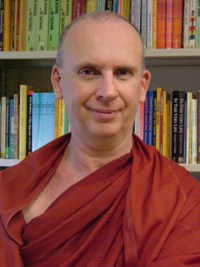I think it’s true to say that Buddhism generally
is and is for the most part thought of as being a peaceful religion. Given this
it is curious how often the poor old
peace-loving Buddha has been associated in one way or another with instruments
of death. The earliest known depiction of a gun is to be found in a painting of
the Buddha being attacked by Mara’s army from Dunhuang (10th
century) in China. In the top right-hand of the painting is one of Mara’s
minions pointing a ‘fire lance’ (Chinese huo
giang) at the Buddha. The fire lance was the prototype of the gun. Moving to
our own times, in 1944 India initiated research into nuclear technology. One of
the first parliamentary decisions of the newly independent country was to pass
the Atomic Energy Act 1948 for developing nuclear energy for peaceful purposes,
but of course with an eye on building bombs. Mahatma Gandhi was safely dead. In
1954 the nuclear weapons program got into full swing and by 1974 the first bomb
was ready for testing. The building and testing of this bomb was codenamed, somewhat
eerily, “Smiling Buddha”.
Wednesday, May 13, 2015
Monday, May 11, 2015
Saturday, May 9, 2015
The Bud In The Hood
The 11th Avenue resident in Oakland's
Eastlake neighborhood was simply feeling hopeful in 2009 when he went to an Ace
hardware store, purchased a 2-foot-high stone Buddha and installed it on a
median strip in a residential area at 11th Avenue and 19th Street. He hoped
that just maybe his small gesture would bring tranquillity to a neighborhood
marred by crime: dumping, graffiti, drug dealing, prostitution, robberies,
aggravated assault and burglaries. What happened next was nothing short of
stunning. Area residents began to leave offerings at the base of the Buddha:
flowers, food, candles. A group of Vietnamese women in prayer robes began to
gather at the statue to pray. And the neighborhood changed. People stopped
dumping garbage. They stopped vandalizing walls with graffiti. And the drug
dealers stopped using that area to deal. The prostitutes went away. I asked
police to check their crime statistics for the block radius around the statue,
and here's what they found: Since 2012, when worshipers began showing up for
daily prayers, overall year-to-date crime has dropped by 82%. Robbery reports went from 14 to three,
aggravated assaults from five to zero, burglaries from eight to four, narcotics
from three to none, and prostitution from three to none. "I can't say what
to attribute it to, but these are the numbers," a police statistician told
me. Back in 2009, when word got around that Stevenson was the person who'd
installed the statue, offerings began to appear on his doorstep. It was like a
scene straight out of the Clint Eastwood film "Gran Torino."
"They left a ton of fruit and Vietnamese specialty foods and candy, but
there's only me and my wife, Lu, here and we can't eat all that stuff - but
it's so good," said Stevenson. "I've tried to explain to them my
reasons" for placing the statue, he said. "I have nothing against it,
but I don't believe what you believe!" I don't think it matters to them.
To this day, every morning at 7, worshipers ring a chime, clang a bell and play
soft music as they chant morning prayers. The original statue is now part of an
elaborate shrine that includes a wooden structure standing 10 feet tall and
holding religious statues, portraits, food and fruit offerings surrounded by
incense-scented air. "This used to be a huge spot for dumping stuff,"
said Alicia Tatum, 27, on an early morning walk with her dogs Lulu and Mya.
"But over time, it's blossomed with more and more and more flowers - and
they are out there every morning like clockwork." On weekends, the
worshipers include more than a dozen people: black folks, white folks, all
folks, said Andy Blackwood, a
neighborhood resident. Two weeks ago, a group of German tourists visited the
shrine. "The dope-dealing has stopped, the ladies of the evening have
stopped," Blackwood said. The Buddha has withstood two attempts to remove
him from his watch, one criminal and one governmental. Neither has worked. Soon
after its installation, a would-be thief tried to pry the statue from its
perch, but Stevenson had secured him with reinforced iron bar and "$35
worth" of a powerful epoxy - and Buddha didn't budge. In 2012, after a
resident's complaint, the city's Public Works Dept tried to remove the statue
but received such passionate blowback from neighbors that city officials
decided to table and "study" the issue. Two years later, the administrative
effort is long forgotten, and Buddha is still there. When I went to visit the
shrine, four small-framed ladies who don't speak or understand English decided
I looked like a convert. The moment I started talking, one of them politely
took my pen from one hand, my notepad from the other and directed me to clasp
my hands together, bow and repeat after her - so I did. When in Rome, right?
Apparently, my Buddhist chants aren't half bad either because they won some
approving "oohs and aahs" from the flock - and carried me to Step 2
in the conversion process. The same woman who had grabbed my gear sat me
cross-legged on a prayer rug in the street and placed a stool with a book on it
before me. If nothing else, Buddha and I share the same body type - short,
squat and happy. I sat there for a moment thinking that I might resemble him -
and maybe that's why they seemed to like me.
By Chip Johnson for Sfgate.
Subscribe to:
Posts (Atom)













